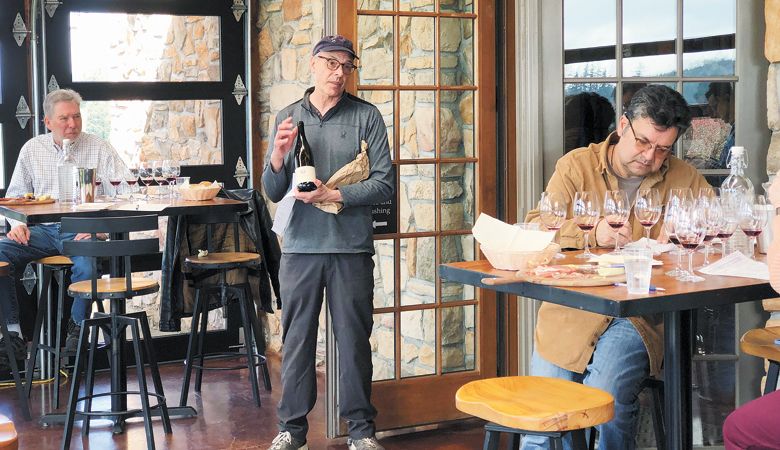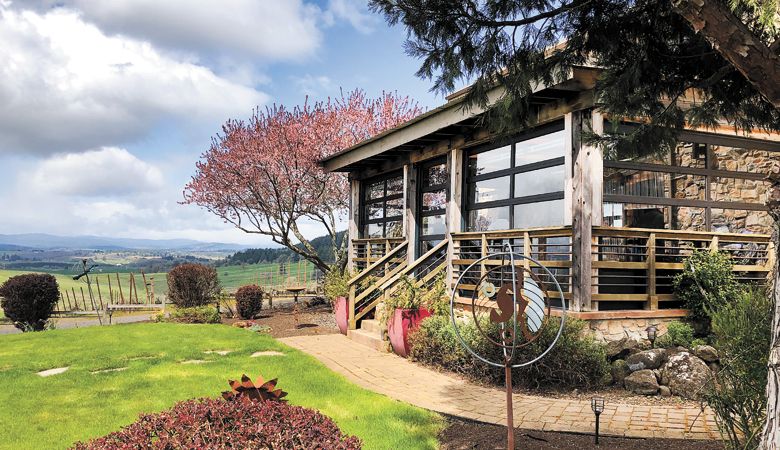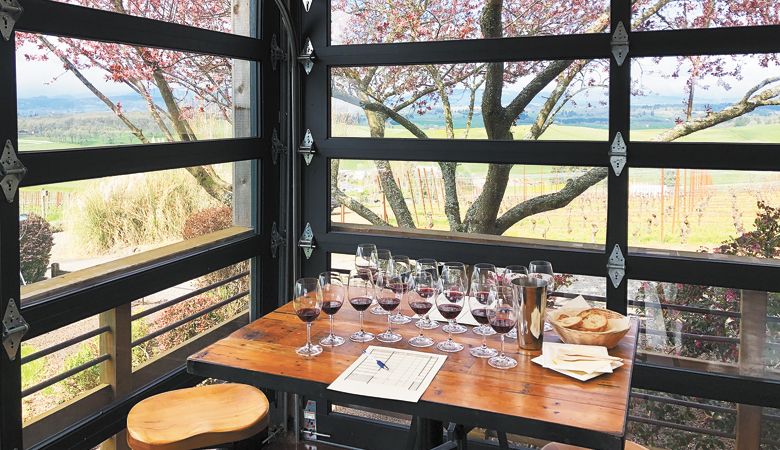Blind Date
Lenné Estate Pinot tasting a risky but educational experience
I’ll admit, they make me a little nervous: an arc of eight wine glasses, clear as diamonds, glitters at me in the slanting spring sunshine at the Lenné Estate tasting room. Each one contains a ruby sample of a 2019 Oregon Pinot Noir, and I get to evaluate them. Yikes. While I’m here to judge them, it feels a little like they’re judging me — like facing a hiring committee or a jury that’s evaluating my wine-tasting chops.
About five times a year, Lenné offers blind tastings, a departure from the usual tasting room experience of simply sampling several wines from the host winery. While the theme varies, the one constant is that Lenné actually pours multiple wines from other makers in a bold and confident invitation for comparison.
It’s quite unusual to be served anything but the in-house label at a tasting room, for obvious reasons: Tasting rooms are conceived to showcase their own wines. In fact, it sounds risky — what if the Lenné wine ranks poorly? Founder Steve Lutz isn’t worried. With a 10-year track record of offering blind tastings against the competition, the winemaker/winegrower says, “To be honest, we’ve come in in the middle a couple of times, but we’re almost always in the top end of the pack.”
Lutz prioritizes wine education and transparency overselling his product, and it’s paid off. These sell-out renegade reversal tasting events attract guests from around the state and beyond, eager to experience professional-style wine tasting in the broader context of comparing multiple wineries and their bottles.
The Lenné Estate tasting room features a main room as well as an enclosed patio with roll-up glass garage doors on three sides framing vineyard views. Soon, both spaces fill with couples, trios and small groups, each seated at their own table for maximum COVID consciousness. Next, Lutz explains our mission: taste and compare.
Gorgeous Vintage
All the wines in this blind tasting are 2019 Oregon Pinot Noirs, ranging mostly from $50 to $80. “I used to always expect to come in at No. 1 or 2,” says Lutz, but “wine quality, in general, has really elevated; that’s true worldwide. Science has elevated wine quality, but that’s made it more homogenous, in my opinion, and that’s why I think Oregon and single-site wines are more relevant than ever.”
Vintage 2019 is “a really gorgeous vintage, one of my favorites,” says Lutz, comparing it to 2016. Both years had an early spring, moderate weather and were dry through harvest, so “they’re perfectly balanced, [which is] what I really love in a vintage.”
“My tastes have evolved a lot since I first started,” he recalls. “Back then, I would have done back flips for a vintage like the 2008 — a little warmer, higher in alcohol. Alcohol is the great cheater because it volatilizes things and brings them up so you can smell them, and also gives you some weight in the front of your palate. So, I was always suckered in by those wines.
“But the more I do this and especially see how wines age, the more I love vintages like 2019,” Lutz continues. “We had some small, thick-skinned berries and a really moderate growing season, ending up with wines that are dense — in fruit — but they never feel heavy in alcohol. So, when these wines age out, they get this beautiful, velvety richness. They’ve got it all, they’re rich, but somehow under it all, they’re still light on their feet. I think you’ll start seeing a lot of hype for 2019.”
First Impressions
As for the tasting guidelines, Lutz instructs us not to discuss our thoughts on the wine, because that makes people second-guess their own evaluation. “First impressions are the best impressions. You can really over-think this — analysis paralysis. This is only one way to taste wine. The other way is to sit with a bottle,” he acknowledges. “You can be fooled on a taste, you really can, but on the other hand, this is the way professional wine tasters taste wine. Taste and smell are very, very complicated, no right or wrong answers. The way we perceive wine changes with our mood, our palate, and what we’re doing. All I’m really trying to do is get you to think about what you like in wine and what floats your boat the most.”
And the tasting begins. In the hush of the room, glasses clink gently as guests sniff, gaze and savor. We’ve got a blank scorecard to make notes, with columns for appearance, taste, aroma and rank. Over the course of 30 minutes, we taste and compare, jotting down impressions in near silence. Finally, we grade them.
The Ranking
The cards are collected and the tabulation begins while the guests erupt in gentle conversation over platters of cheese and charcuterie. Soon, Lutz returns with the results. He has also blind-tasted all eight wines. He begins the unveiling. The first wine, a $50 Pinot from nearby Gaston, is ranked No. 1 — I feel vindicated; I ranked it number two. Lutz, however, was more critical, noting a “thin back end.”
The second bottle, $80 and from the same vineyard, was voted No. 2. The third wine ties for third —exactly where I ranked it. The wine turns out to be batting for the home team: Lenné Estate Eleanor’s 114, priced at $60, showed aromatics of mocha and violets, according to some. Yes, Lutz identified it while blind tasting; no, I didn’t discern the violets.
According to Eric Bruce, the tasting room manager: “All the wines were quite good, and the voting was unusually close. Even the seventh and eighth places, by group consensus, received multiple votes for first, second and third place on various ballots. And each of the top four wines received at least a couple of seventh or eighth votes on other ballots.” This information helped calm my performance anxiety, and affirm, like Lutz says, “It’s all about what floats your personal boat.”
Tasting and critiquing so many similar, high-quality wines from an exceptional vintage underlines the challenges winemakers must overcome throughout the process. These wines, all from the same year, the same grape and region, the Willamette Valley, reveal so many subtle variations when you take the time to focus. Lutz isn’t afraid to put his wines head-to-head with the competition, and he makes sure the competition represents excellent specimens of Oregon’s single-site wines.













